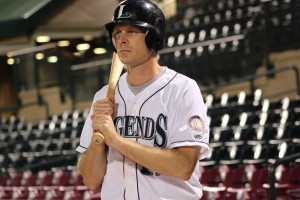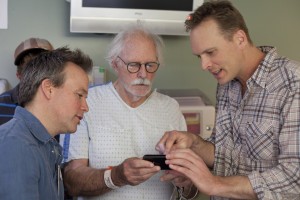This article also appears on page 6 of the October 11 print edition of Ace Weekly.

cover image of Lexington, photo by Ian Davis
Lexington Native Son Richey Nash comes home for a hit
by Brian Gardner
Hitting the Cycle is a baseball movie that’s not about baseball. Filmed entirely in Lexington, the movie premieres this week at the Kentucky Theatre. Starring J. Richey Nash in the lead role and Bruce Dern as his father, Hitting The Cycle examines the life of a once promising prospect as he confronts the fact that his baseball career may be coming to an end.
J. Richey Nash is a Lexington native (son of UK basketball legend Charles “Cotton” Nash) who carved his own unique career path. After playing basketball and baseball at Henry Clay High School, Nash was recruited to play college hoops. He took his talents to the Ivy League where he played basketball for Princeton. He always maintained his passion for baseball and though recruited only as a basketball player, he played both sports for his first two years. Knowing that playing both would allow him to master neither, Nash made the tough choice to abandon the sport for which he was recruited and concentrate his athletic efforts entirely on baseball.
Upon graduation from Princeton, Nash was drafted by the San Diego Padres in the Major League Baseball draft. He spent a few years in the Padres minor league system before giving up on the baseball dream and moving to New York City to begin an acting career. The former ballplayer traded his spikes for the bright lights and now lives in L.A.
Hitting The Cycle brought both Nash and his film alter ego, “Rip” Ripley, back home to Lexington. Ripley came home to confront his past, while Nash returned to embark on a new career as a filmmaker.
“An actor is always looking for parts to play,” he says, “so I wanted to write a screenplay and cast myself in the lead. Since I love baseball it was a natural vehicle for the story.”
That was just the beginning, he says. “There was a period of a few years when I shopped the script around to various producers and production companies to see if I could garner some interest. However, the prospect of financing a movie starring a relatively unknown actor (me!) didn’t prove very attractive to the Hollywood establishment. After this, there was another year and a half of attempting to raise funds independently to shoot the film. Unfortunately the country had just experienced the near collapse of the financial system and investment money was scarce.”
This is where his Lexington roots came in. “In the spring of 2010, I returned to Kentucky to start pre-production and I began talking with people here in the Lexington area about making the film. To my surprise, I quickly found my first investor, and from there all the pieces miraculously fell into place. In just a few short months we ended up raising enough money (mostly in state) to get us through principal photography, and by the fall of that year we had raised all the capital needed to complete the movie. Beyond our investors, several local businesses and individuals donated locations, resources, products and services, and most importantly their time.

Alan Stein (a fellow Henry Clay alum) came on board with the Lexington Legends’ ballpark and uniforms. L.A. film editor and Lexington native Harry Miller signed on and then recruited his brother as a co-producer, Stein’s Blue Devil classmate (award-winning journalist) John Winn Miller. Lexington filmmaker George Maranville (100 Proof) served as assistant director and supervised the tech crews. Arthur Rouse recruited crew members from the Kentucky Film Lab and the BCTC filmmaking program.
Nash says, “Lexington was a kind of template for where the story takes place. So naturally it was a perfect fit for the movie. And the fact that I grew up here and still have family and relationships in the area made it an easy choice.”
He adds, “locations included the Lexington Legends stadium, Chevy Chase Inn, Al’s Bar, Atomic Cafe, Lafayette High School, Masterson Station and Veterans Parks, the Kentucky Clinic, Good Samaritan Hospital, the gardens at Ashland/Henry Clay’s Home, Calvary Cemetery,” and a few private homes.
The film is well served by Nash’s background on the diamond.
“We made this on a tight budget,” he says, adding “People who’ve seen it can’t believe the quality of the film for what we spent.”
Whether confidently swinging in the batter’s box or gliding smoothly toward an outfield fly ball, Nash IS a ballplayer rather than a miscast actor trying to look like one. The authenticity of the on field shots enhance Hitting The Cycle, along with the footage from Legends games. The film doesn’t fall into the trap of many sports movies which show the human drama entirely through athletic competition. Action footage enhances this story but does not replace it.
In addition to writing and starring, Nash served as Co-Director and Co-Producer of this independently produced film. He’s taken his film to four film festivals and won an award at each one. Most notably, Hitting the Cycle was chosen for the Best Dramatic Feature Film award at the 2012 Manhattan Film Festival earlier this year in New York.
Similar to the movie going four for four in festival awards, the lead character, “Rip” Ripley gets four base hits in his very first Major League game, played at Yankee Stadium. In fact, he hits for “the Cycle” getting a single, double, triple and home run all in one game. This quirky accomplishment is the kind of thing baseball fans love to make note of and recall years later with fondness and admiration.
After such a glorious beginning, Rip continues to have a stellar rookie campaign. But ultimately he suffers a devastating knee injury that takes him out of the big leagues and back to the lowly minors. Like many players Rip is forced to rehabilitate his injury while playing in lesser games in the lower levels of professional baseball. These games, filmed in Lexington, show Rip’s Major League skill handicapped by his knee injury. Minor league baseball is a tough life with constant bus travel and modest accommodations. It’s made even tougher once you’ve been to “The Show” and had a taste of the big time.
Rip’s sole purpose in toiling in the minors is to work his way back to Yankee Stadium. Even in the lights off Broadway, Rip finds comfort in the solitude of the outfield and the warmth of the infield dirt. It seems the only place Rip finds peace is on the baseball diamond. He is chased by demons both real and imagined and can only outrun them on the base paths.
Rip’s edgy tone and demeanor only soften when talking about his joyful game. His eyes sparkle and as he describes swinging the bat “clean through the air” and connecting with the ball. No joy can be greater than driving a baseball out of the park and watching as it clears the fence. This man of little sentiment and warmth still recalls hitting his first little league home run and the happiness provided by that one swing of the bat.
Ultimately Rip must return to his hometown of Sayreville, the scene of his greatest accomplishments and deepest failures. Lexingtonians will quickly recognize Lafayette High School, Morton Middle, and the Chevy Chase Inn, among other local spots. The hometown hero is greeted warmly by fans and followers, but distantly by those who know him best. Rip left town on less than good terms and the hard feelings haven’t softened over time. He hasn’t spoken to his family in years.
In pursuing his baseball dream and traveling from town to town, Rip has put his past in the rear view mirror. He’s missed funerals and weddings all in an effort to suppress his painful past. He is still an angry young man who is surprised to learn that everyone has moved on except him.

When his baseball career is interrupted, the man who never looked beyond the next game is now forced to examine the next season of his life. Rip has not seen his estranged father, played adroitly by Bruce Dern, in years. Hitting The Cycle lightly touches, but doesn’t overplay this dysfunctional father son relationship. (Nash says, “We didn’t know this going in, but Bruce is a huge sports fan. So when he read the script, he immediately identified with the material.”)
Many a man has been stymied in healthy development by the lack of a loving father offering a strong but supportive hand. Until a man can come to terms with this absence he cannot come to terms with himself. Rip learns this the hard way.
Through time and circumstance Rip is forced to finally make tough choices which he can no longer outrun. It’s as if the bases are loaded in the bottom of the ninth with two outs and a full count. On the next pitch something must happen, though we wish at times we could deny the finality of the moment. Rip is ominously told that “sometimes the right decision is the hardest one to make.”
It’s easy to see how Nash created this character, Rip, having dealt with some hard choices of his own. The existence of this movie is testament to the perseverance and hard work of Nash and his team piecing together a quality independent film. This is a story well worth telling
The viewers will be well rewarded in watching this film and enjoying the local flavor, but even moreso by the journey of self exploration and homecoming. Enjoying rookie success similar to that of Rip, Nash’s Hitting The Cycle knocks it out of the park.
The movie will premiere at the Kentucky Theatre on Thursday October 11, 2012 at 7:30 pm. The film will show at the Kentucky through the weekend of October 12 through October 14.
Also in this issue:
p 5 Lexington in the Washington Post: Writer Roams Our Cheapside Square
p13 Chef Tom: Tomatoes in the Pumpkin Patch
p11 Movies: Taken 2
p12 Movies: The Master, an Interpretation by Raj Ranade
p14 A Kentucky Reader’s Guide to the Southern Festival of Books by Heather C. Watson








